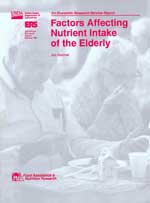Factors Affecting Nutrient Intake of the Elderly
- by Jon Weimer
- 10/21/1998
Overview
The rapid expansion of the population age 60 and older has a number of economic implications. The people in this group, about 18 percent of the population, account for about 30 percent of all health care expenditures. They use hospitals at nearly three times the rate of younger persons, average seven to eight medical visits per year, and occupy the majority of nursing residence beds. Providing information on the relationship of socio-economic and other factors to nutrient intake is basic to improving the health and well-being of the elderly. This exploratory investigation provides estimates of the effects of selected characteristics of the household and its constituents on individual nutrient consumption of elderly heads of households. Formal education was positively related to nutrient consumption. The elderly who live in households with income below 130 percent of the poverty level tended to have lower nutrient intakes than those elderly in households with higher incomes. Blacks, urbanites, and Southerners generally consumed less of the selected nutrients. Neither participation in the Food Stamp Program nor receipt of surplus foods was a significant factor in nutrient intake of elderly individuals. Possible nutrition interventions focus on targeted audiences and programs.
Download
-
Entire report
Download PDF


